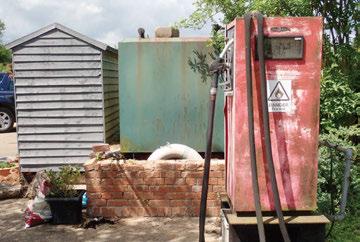CAMPAIGNING WITH YOU The ruling over red diesel and the impact of the HS2 Phase 2b route are among some of the issues we’ve been campaigning on with your help. Here’s how we’ve been doing…
HS2 design refinement consultation IWA has responded to the Government’s latest HS2 Phase 2b consultation, with proposed changes affecting parts of the Coventry, Erewash and Nottingham canals and the Aire & Calder Navigation. Although there are some benefits for the waterways from these changes, there are additional impacts and several earlier concerns remain unresolved. On 21st August the Government announced a comprehensive review into the whole high-speed rail project, including its benefits, impacts, affordability, efficiency, deliverability, scope and phasing, with a report due by “the autumn” and a decision on whether or how to proceed expected by the end of the year. Meanwhile, various preparatory works continue, including archaeological digs, demolitions and utility diversions. Phase 2a has now been passed by the House of Lords, and changes to Phase 2b have also been announced. Our response was submitted to the latest consultation on design refinement proposals for Phase 2b, Crewe to Manchester and West Midlands to Leeds, which closed on 6th September. The proposed changes affect the Coventry Canal at Polesworth, the Erewash Canal at Sandiacre and Stanton Gate, the unrestored Nottingham Canal, and the Aire & Calder Navigation near Fishpond Lock. At Polesworth an access road is now proposed close to the Coventry Canal and the moorings at Pooley Country Park. We have asked for the road to be set back and access to the moorings maintained; the need for more noise fencing on the viaduct and embankment has also been reiterated. At Stanton Gate a change to the HS2 route avoids the need to divert the M1, so the motorway bridge over the Erewash Canal will no longer need to be demolished and replaced, saving much
disruption. However, there will be a new road-bridge. An auto-transformer station that needs screening, concerns about the height of the viaduct, the design of two very skew canal crossings and the need for noise protection are all issues affecting the Erewash Canal that remain. The Nottingham Canal at Trowell, although abandoned, is part of a longdistance footpath and local nature reserve, and could be restored back to Langley Mill. But the new HS2 route would sever it with a deep cutting and we have asked for an aqueduct to maintain the continuity of the towpath and the water supply. The Aire & Calder Navigation will be affected by moving the route onto a viaduct from Woodlesford past Fishpond Lock to Rodhill Corner. We have asked that the viaduct piers should not narrow this commercial navigation, for more information on the design and visual impact, and for noise barriers to protect recreational canal users. The full response from IWA can be viewed online at waterways.org. uk/lichfield/pdf/hs2_phase2b_dr_ response_2019.
A proposed access road will interrupt peaceful moorings at Polesworth on the Coventry Canal.
The M1 crossing over the Erewash Canal near Stanton Lock will no longer need to be demolished and rebuilt.
The transition to white diesel will make red diesel pumps redundant across the network.
Response to red diesel ruling As well as encouraging individual boatowners, boatyard operators and diesel suppliers to respond to the Government’s consultation about red diesel, IWA has now submitted its feedback to HMRC on the ‘Implementation of the Court of Justice of the European Union judgment on diesel fuel used in private pleasure craft’. IWA’s submission outlines a number of problems which will arise as a result of the implementation of the ruling. The key concern is that boatyards on the UK’s inland waterways, most of which currently only sell red diesel, will be faced with the choice of either installing an additional tank to provide white diesel, or changing their entire supply of red diesel to white diesel. It is likely that the majority of boatyards and marinas would continue to sell only red diesel, particularly those that operate a hire-boat fleet or have residential moorings. Consequently, owners of privately owned pleasure craft needing to refuel their boats with white diesel will struggle to find a boatyard that sells it. The likely rise in the use of portable fuel cans would present significant environmental risks arising from the inevitable spillages; the use of generators in confined spaces and in urban areas also poses a threat to the health and safety of waterways users. IWA has asked HMRC to mitigate these problems by: • Continuing with the current arrangements, which were reached after a significant period of consultation and discussions in 2008, until the situation regarding the UK’s membership of the European Union is clearer • Adopting the longest possible transition time to implement the ruling to allow sufficient time (including raising finance) for boatyards to install new or convert existing tanks, and for boaters to undertake any necessary modifications to their vessels • Providing written confirmation that HMRC will allow existing red dye in fuel tanks to fade naturally, and to allow time for existing stocks of red diesel purchased prior to any change to be used up without having to waste and dispose of any dyed fuel.
Why campaign with IWA? We strive to make the waterways better for all. 12
| IWA Waterways
012 Campaigns Update AH.indd 12
Winter 2019 23/10/2019 14:04









